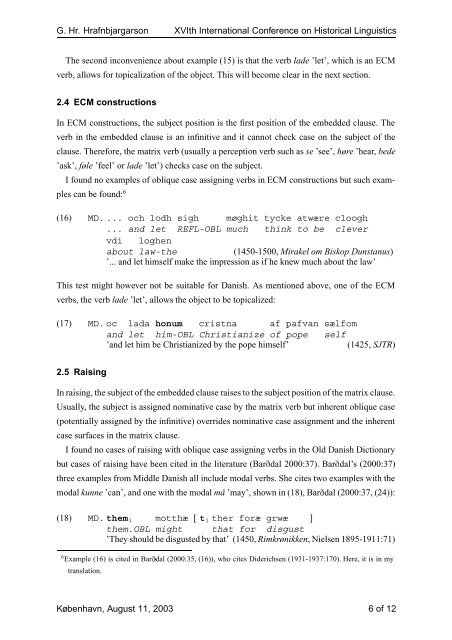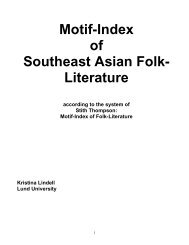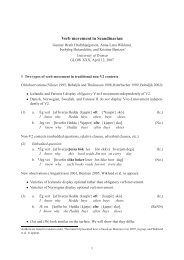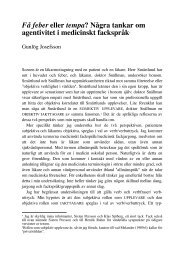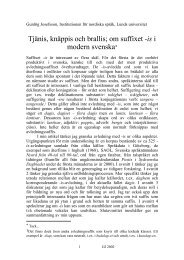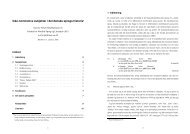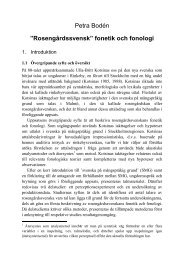Non-Nominative Subjects in Old and Middle Danish
Non-Nominative Subjects in Old and Middle Danish
Non-Nominative Subjects in Old and Middle Danish
Create successful ePaper yourself
Turn your PDF publications into a flip-book with our unique Google optimized e-Paper software.
G. Hr. Hrafnbjargarson XVIth International Conference on Historical L<strong>in</strong>guistics<br />
The second <strong>in</strong>convenience about example (15) is that the verb lade ’let’, which is an ECM<br />
verb, allows for topicalization of the object. This will become clear <strong>in</strong> the next section.<br />
2.4 ECM constructions<br />
In ECM constructions, the subject position is the first position of the embedded clause. The<br />
verb <strong>in</strong> the embedded clause is an <strong>in</strong>f<strong>in</strong>itive <strong>and</strong> it cannot check case on the subject of the<br />
clause. Therefore, the matrix verb (usually a perception verb such as se ’see’, høre ’hear, bede<br />
’ask’, føle ’feel’ or lade ’let’) checks case on the subject.<br />
I found no examples of oblique case assign<strong>in</strong>g verbs <strong>in</strong> ECM constructions but such examples<br />
can be found: 6<br />
(16) MD. ... och lodh sigh møghit tycke atwære cloogh<br />
... <strong>and</strong> let REFL-OBL much th<strong>in</strong>k to be clever<br />
vdi loghen<br />
about law-the<br />
(1450-1500, Mirakel om Biskop Dunstanus)<br />
’... <strong>and</strong> let himself make the impression as if he knew much about the law’<br />
This test might however not be suitable for <strong>Danish</strong>. As mentioned above, one of the ECM<br />
verbs, the verb lade ’let’, allows the object to be topicalized:<br />
(17) MD. oc lada honum cristna af pafvan<br />
<strong>and</strong> let him-OBL Christianize of pope<br />
’<strong>and</strong> let him be Christianized by the pope himself’<br />
sælfom<br />
self<br />
(1425, SJTR)<br />
2.5 Rais<strong>in</strong>g<br />
In rais<strong>in</strong>g, the subject of the embedded clause raises to the subject position of the matrix clause.<br />
Usually, the subject is assigned nom<strong>in</strong>ative case by the matrix verb but <strong>in</strong>herent oblique case<br />
(potentially assigned by the <strong>in</strong>f<strong>in</strong>itive) overrides nom<strong>in</strong>ative case assignment <strong>and</strong> the <strong>in</strong>herent<br />
case surfaces <strong>in</strong> the matrix clause.<br />
I found no cases of rais<strong>in</strong>g with oblique case assign<strong>in</strong>g verbs <strong>in</strong> the <strong>Old</strong> <strong>Danish</strong> Dictionary<br />
but cases of rais<strong>in</strong>g have been cited <strong>in</strong> the literature (Bardal 2000:37). Bardal’s (2000:37)<br />
three examples from <strong>Middle</strong> <strong>Danish</strong> all <strong>in</strong>clude modal verbs. She cites two examples with the<br />
modal kunne ’can’, <strong>and</strong> one with the modal må ’may’, shown <strong>in</strong> (18), Bardal (2000:37, (24)):<br />
(18) MD. them i motthæ [ t i ther foræ grwæ ]<br />
them.OBL might that for disgust<br />
’They should be disgusted by that’ (1450, Rimkrønikken, Nielsen 1895-1911:71)<br />
6 Example (16) is cited <strong>in</strong> Bardal (2000:35, (16)), who cites Diderichsen (1931-1937:170). Here, it is <strong>in</strong> my<br />
translation.<br />
København, August 11, 2003 6 of 12


